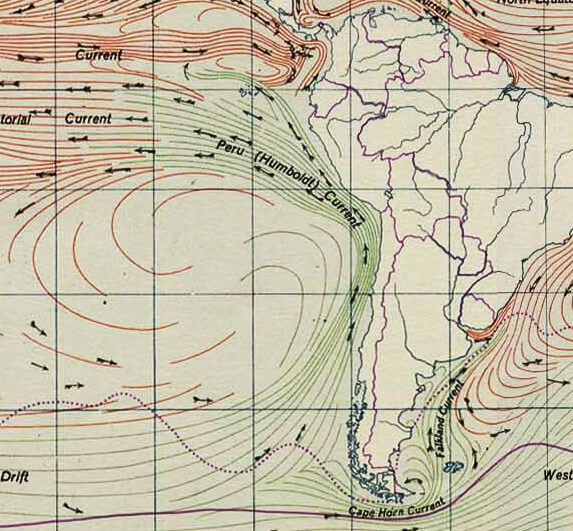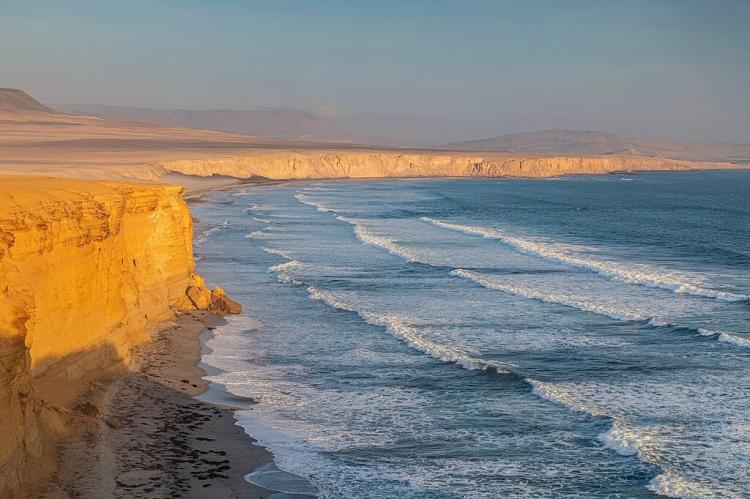The Humboldt Current: A Lifeline in the Eastern South Pacific
The Humboldt Current, or Peru Current, is one of the world's most important ocean currents and a significant marine phenomenon in the eastern South Pacific. It is a distinct marine environment characterized by its cold, nutrient-rich waters and the unique ecological communities that thrive within it.
The Humboldt Current
A Lifeline in the Eastern South Pacific
The Humboldt Current, also recognized as the Peru Current, is a formidable force in the eastern South Pacific Ocean, earning its place as one of the world's crucial ocean currents. Originating in the frigid Antarctic region, this marine phenomenon navigates northward along the South American coastline, profoundly impacting climate, aquatic life, and the fishing industry along the western flank of South America.
Named in honor of the pioneering German naturalist Alexander von Humboldt, who conducted groundbreaking research in the region during the 18th and 19th centuries, this cold-water giant is a critical player in shaping the oceanic landscape.
Geographical Scope and Origin
The Humboldt Current gracefully flows northward along the western coast of South America, stretching from the southern tip of Chile to the northern reaches of Peru. It is an integral component of the expansive South Pacific Gyre, influencing the oceanic circulation in the broader South Pacific Ocean. Originating in the icy embrace of the Antarctic, this cold-water mass extends 500 - 1,000 kilometers (300 - 600 miles) offshore, maintaining temperatures ranging from 14 to 24 °C (57 - 75 °F).
Marine Ecosystem
Beyond its role as a current, the Humboldt Current is a thriving ecosystem in its own right. Its distinct marine environment is characterized by cold, nutrient-rich waters that give rise to unique ecological communities. This aquatic wonderland becomes a bustling stage for marine life, with nutrient-rich waters fostering the growth of phytoplankton, the foundational element of the marine food web. Fish, seabirds, marine mammals, and invertebrates dance harmoniously within this rich underwater tapestry, making it a vital breeding ground for various aquatic species.
The Humboldt Current's ability to induce upwelling is a defining feature. Prevailing winds push warm surface waters away from the shore, allowing nutrient-rich waters from the deep ocean to ascend. This process, known as upwelling, replenishes the surface with essential nitrates and phosphates, creating an ideal environment for phytoplankton growth and sustaining the intricate marine ecosystem.
Climate Impact
The presence of the Humboldt Current plays a pivotal role in shaping the climate along the western South American coast. The cool, arid climates of the Atacama Desert in Chile and the Sechura Desert in Peru owe their existence to the Humboldt Current. This cold-water giant inhibits moisture evaporation, resulting in limited rainfall in these coastal regions. Additionally, it contributes to the formation of coastal fog, locally known as "garúa," and provides crucial moisture for the arid landscapes.
On a global scale, the Humboldt Current is a climate regulator, transporting heat from the equator to the poles. Furthermore, it plays a significant role in the El Niño-Southern Oscillation (ENSO) cycle, a climate pattern with far-reaching effects on weather patterns worldwide.
Challenges and Conservation
The Humboldt Current confronts various challenges, including the impacts of climate change, overfishing, and pollution. Despite these challenges, its importance to the marine life, climate, and economies of the countries it traverses remains indisputable. Efforts in conservation and sustainable practices are essential to safeguard this vital ecosystem and ensure its continued resilience in the face of evolving environmental pressures.
In conclusion, the Humboldt Current is more than a mere current; it is a lifeline of cold riches that sustains life along the western South American coast. From its frigid origins in the Antarctic to its transformative impact on climate and marine ecosystems, this oceanic giant continues to captivate scientists, conservationists, and admirers alike. As we navigate an era of environmental challenges, the Humboldt Current beckons us to appreciate its role and work collectively to preserve this extraordinary force of nature.

Map depicting the Humboldt / Peru Current.
